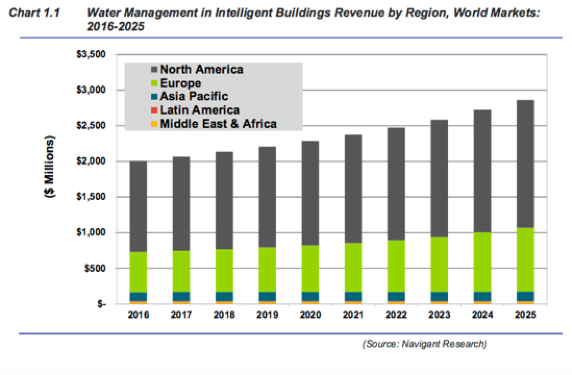Internet of Things (IoT) devices and sensor technology are becoming more common in commercial building management. This smart building management technology provides building owners and occupants with real-time data that can drive or automate decisions, reduce costs and waste less resources.
The growing trend of remote, telecommuting office workers, for example, can be addressed with occupancy sensors that detect the presence or absence of employees in work spaces so that the building is only being lit, cooled, or heated where necessary. According to a recent study, the average office building can save 18% of its building energy use through installation of smart technologies.1
Some of these systems can also accommodate feedback from tenants or office workers. Comfy, a smart workplace phone or computer app, asks users for their workplace temperature preferences, aggregates the data, and then instructs the building’s smart energy system to automatically adjust temperatures to keep the workspace comfortable.
Why Smart Water Management is Starting to Gain Notice
While the focus of IoT devices in smart building management has centered on energy savings, their ability to also deliver water savings is starting to gain notice. A 2016 Ecova survey of energy, facility, finance, and sustainability managers found that 57 percent had invested in water conservation measures. The surveyed group viewed water reduction efforts, such as irrigation controls and behavioral change, as low-cost or no-cost priorities. 2
Today, smart water management investments are simple to install and quick to pay for themselves. When asked about water conservation investment decision making, Rachel Baker, the environmental stewardship manager at Kaiser Permanente, said, “If possible, start outside the building with irrigation and landscaping. It’s the easiest to implement, by far.” 3
Baker said water management was completely different from energy management.
“When something (in the energy system) breaks, in most cases, it doesn’t suck a ton of energy. Energy management is relatively predictable by season,” she said. “But with water, you could be doing amazing (against budget) and then suddenly the mainline breaks, and if you don’t know about it for a period of time, then you’re not doing amazing. Water use at one of our best (performing) service areas shot up 40% for that year as a result of a mainline break.”3
Water Management Technology Market Forecasted at $2.8 Billion by 2025
After irrigation, the next step is to incorporate smart water technologies into facilities management, which is the direction in which things are headed, according to a report from Navigant Research.
Global investment in water management technologies and services is expected to grow from $2 billion to $2.8 billion in 2025 as water management becomes a standard component of smart buildings, the report says. As corporate sustainability initiatives and energy efficiency become more important, smart building technology vendors are beginning to showcase more comprehensive tools, including some created especially for water conservation and management.2
“Major corporations are feeling greater pressure from shareholders and customers to demonstrate action on sustainability,” says Casey Talon, principal research analyst, Navigant Research. “Customers are taking the opportunity to manage water consumption with specific steps that make good economic sense, because today the bottom line is still the major driver in business investment. Water-efficient plumbing, irrigation management and monitoring software are three technology areas gaining traction.”2
Effectively Manage Facility Water Use with Smart Water Management Technology
Smart water management technology provides the data and tools to help you more effectively manage water use. Data collected with smart water devices is being integrated with building management systems to show how much water you’re using and so that you can target areas where you can use water more efficiently.
Here are some ways that smart water management tools from HydroPoint can help you reduce water waste:
- Integrated dashboards reporting real-time water use help you manage to water restrictions or outdoor irrigation water budgets.
- 24-hour water usage monitoring and reporting help you detect water leaks, big and small, indoors and outdoors. Leak alerts can be sent to a computer or a mobile device.
- Automated irrigation schedules based on weather or soil moisture data ensure plant health, as well as guard against overwatering landscapes and reduced plant loss, hardscape damage, common area hazards, and stormwater runoff.
- Management from a computer or mobile device reduces the need for site visits and wet checks.
Find out why 9 of 10 the largest high-tech companies and 27 of the Fortune 100 selected HydroPoint as their smart water management partner.
Sources:
- ACEEE.org: http://aceee.org/sites/default/files/publications/researchreports/a1703.pdf
- https://www.environmentalleader.com/2016/04/why-water-management-will-take-smart-buildings-to-the-next-level/
- Outsmarting the Drought: https://www.youtube.com/watch?v=2XdKWYQWN-4


